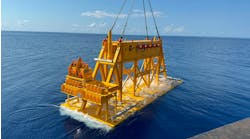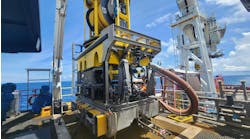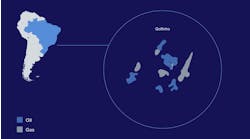Mini-boom adds eight newbuilds to the fleet
Barry Harding
Harding Resources
Judy Maksoud
International Editor
Newbuild jackups are targeting plays in deeper water. Not long ago, deep-water for jackup rigs was considered to be 300 ft. Now, with Rowan's Gorilla series and the Mærsk Innovator, 500 ft water depth is even closer to becoming commonplace.
This year's update to Offshore's worldwide deepwater jackup poster shows 66 rigs capable of 350 ft and greater water depth owned by ten drilling contractors. The top three drilling contractors – GlobalSantaFe Corp., Rowan Companies Inc., and Ensco International Inc. – own 47 (71%) of the 66 rigs.
null
Recent history
Since 1997, 21 deepwater jackup rigs have been or are being constructed. This amounts to almost a mini-boom compared to what the drilling industry experienced during the previous 10 years, when only five deepwater jackups were built.
Prior to 1987, 40 deepwater jackups made up the entire fleet, with build dates going back to 1972. Of those 40 rigs, 78% were not originally constructed with enough leg to drill in 350 ft water depth, but had been upgraded at a later time.
The data gathered for this year's poster shows that Ensco has the youngest deepwater fleet on average as a result of the purchase of Chiles Offshore Co. in 2001, while Rowan has the oldest deepwater fleet. Of the contractors with more than five deepwater rigs, Mærsk Contractors' and Rowan Companies' fleets have the deepest average water depth ratings at 405 ft and 398 ft, respectively.
The US Gulf of Mexico has 29 working deepwater jackups (44%), while the North Sea is the second most populated area with 14 (21%). The remaining 23 deepwater jackups are scattered around the other deepwater drilling areas of the world.
The poster also reveals that eight engineering companies or shipyards have designed the 66 rigs, with most companies having two or more designs.
Six of the deepwater rigs on the poster are the older version slot rigs, while the other 60 are pure cantilever rigs with a plate girder cantilever. Interestingly, the first jackup rig cantilever was installed in 1965 by The Offshore Co. (now part of Transocean Inc.) on the Hustler, according to F. Tim Pease, former vice president of engineering at The Offshore Co. The original cantilevers had only a 30-40 ft reach from the vessel stern and a 1,000-1,100 kip load capacity. This compares to Rowan's Bob Palmer, which has a standard cantilever reach of 75 ft and a 2,500-kip load capacity on center line.
The very first jackup designed for 500-ft water depth was the Harding Production platform, a TPG-500, built in 1995 for BP in the North Sea. That jackup unit is still operational today in the Harding field.
Building on spec
In January 2004, the Skeie Group of Oslo announced it would build two deepwater jackups. The new rigs are a Keppel FELS Mod V B design with 350-ft depth capability, scheduled for delivery within 24 months, and a BMC Pacific Class rig designed for 375-ft depth, to be delivered within 26 months. The units will be built in Singapore by Keppel FELS and PPL, respectively.
The Atwood Beacon (400 ft), Constellation I, (400 ft), Mærsk Innovator (492 ft), and Bob Palmer (550 ft), were delivered in 2003. This year, the Constellation II (400 ft), Tonala, (375 ft), Mærsk XL2, (492 ft), and the Ensco 106, (350 ft), will join the fleet.
Nearly all of the eight rigs delivered or to be delivered this year are being built on speculation, without a firm drilling contract in place prior to construction. This is an interesting phenomenon, given that construction costs for deepwater jackups are typically in the $12- million to $130-million range for a completely built and outfitted unit.
The jackup trends
Recently, there have been a number of deeper-water jackup designs with larger hulls being marketed by the engineering companies and shipyards. Though the larger hull size is not yet a standard in the deepwater jackup industry, the newbuilds as a group do have a number of features in common.
New designs have routinely incorporated AC top drives, conductor tensioning systems, and advanced BOP handling systems. Most of the newbuilds have three 2,200-hp mud pumps, with some rigs outfitted with four pumps, as well as more sophisticated mud processing systems. Nearly all of the newbuilds also have dedicated completion fluid storage.
The rigs also have larger drawworks ratings, ranging from 3,000 to 4,600 hp, and greater crane capacity for lifting leg sections and coiled tubing units.
There is also a trend toward larger quarters, ranging from 100- to 120-person capacity, complete with offices, meeting rooms, gymnasiums, and movie rooms.
The newbuilds include taller, higher-load derricks with 1,500- to 2,500-kip maximum hook load, as well as automated pipe-handling and off-line stand-building capabilities. As a result, the rigs also have larger topside deck areas.
Size matters in the world of deepwater jackups. As size and depth capability increase, so do the technologies that are incorporated in the designs. Today's deepwater jackup fleet boasts greater depth and more advanced drilling capabilities than ever before. And innovative new designs promise even more improvements as jackups push the limits of today's capabilities.




